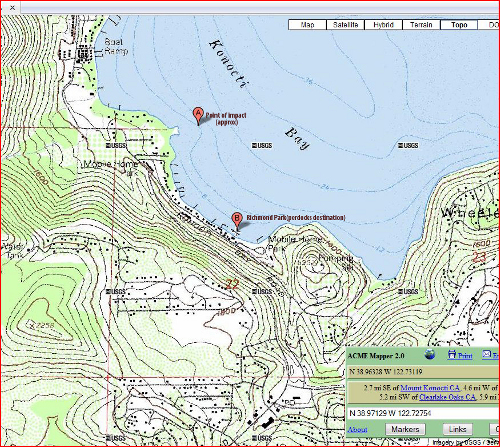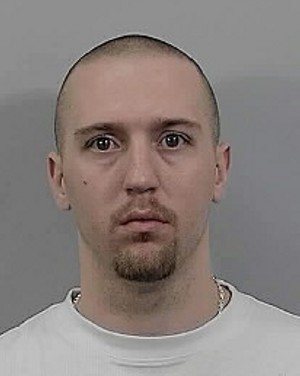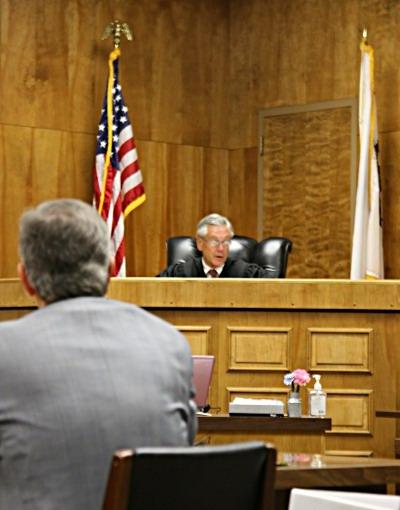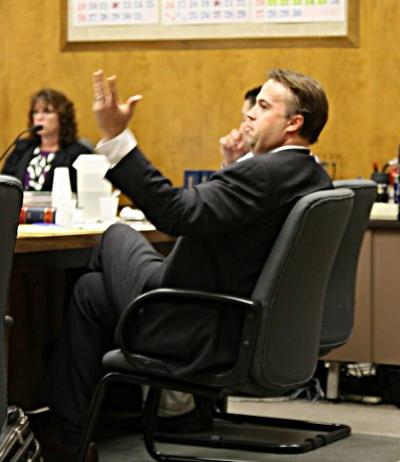- Elizabeth Larson
- Posted On
Prosecution, defense argue final motions before Dinius trial begins
They also argued a motion to allow the jury to visit the scene of a fatal April 2006 boating collision at night, via boat, which the judge delayed ruling on until later in the trial.
Bismarck Dinius was not present in court for the 40-minute hearing, but he was represented by his attorney, Victor Haltom of Sacramento, who appeared along with District Attorney Jon Hopkins before Judge J. Michael Byrne.
A jury was seated on Tuesday. Next Tuesday, testimony in Dinius' trial will begin.
Dinius, 41, is facing felony boating under the influence with great bodily injury and two lesser included offenses of boating with a blood alcohol level over 0.08 and boating while under the influence. The latter two offenses would only be considered if he is not found guilty of the felony charge.
Earlier this week Hopkins moved to have a manslaughter charge against Dinius dropped, as Lake County News has reported.
Dinius was steering a sailboat belonging to Willows resident Mark Weber shortly after 9:15 p.m. April 29, 2006, when the boat was hit by a speedboat driven by Russell Perdock, an off-duty sheriff's chief deputy.
Weber's girlfriend, 51-year-old Lynn Thornton, suffered blunt force trauma injuries to the head in the collision and died a few days later. Perdock was not charged; Dinius faces charges because he allegedly had a blood alcohol level of 0.12; the prosecution also alleges that the sailboat's running lights weren't on.
The hearing Thursday involved “in limine” motions. Proceedings in limine – which means literally “at the threshold” in Latin – are held before a trial starts and out of the presence of the jury.
Issues that were discussed at the hearing included time estimates on the case (Hopkins said he could present his case in two weeks, Haltom estimated he would take less time); renumbering the charges against Dinius; instructing the jury about the manslaughter charge being dropped; and not mentioning the outcome of a civil case related to the crash.
They also agreed on a stipulation that they would not introduce Thornton's autopsy photos, deciding that a pathologist's report would suffice. That will spare her family and friends, and the jurors, from seeing the graphic pictures.
“I don't think there's any dispute in this case about what caused the death,” said Haltom, adding he didn't think the photos were necessary.
The prosecution and defense also agreed with the judge that, at the end of each trial day, they'll disclose what witnesses they'll call the following day in order to be most prepared and help the trial move along more smoothly.
Haltom said that Thornton's son, John, has specifically asked to know when Perdock will appear on the witness stand, because he wants to be there for the testimony.
On Thursday, Byrne opened a sealed envelope of records subpoenaed from REACH Air Medical Services, which transported Thornton to UC Davis Medical Center, where she died three days later, on May 2, 2006. Byrne ordered that copies of the records about the company's response to the collision scene be given to both the defense and prosecution.
Haltom reported that on Tuesday and Wednesday he received a total of 116 pages of new discovery from the District Attorney's Office, including information about a new prosecution expert. “I've got a problem with that.”
He wanted the evidence of the expert – a retired engineer who worked for Baja, the company that manufactured Perdock's 24-foot power boat, and will testify on speed and engine RPMs, and how the boat's speedometer works – precluded from the trial.
Hopkins maintained he's entitled to look at issues about the boat. “I was not the one who insisted the case race into trial,” he said. “This is primarily directed at the issues that the defense is raising. I don't see any reason that it couldn't come in.”
He said he has another criminologist, Raymond Gieszl, who will look at the issue of the light bulbs in the sailboat's running lights, and whether it can be determined by looking at the bulbs whether they were on or off at the time of the crash, versus what witnesses saw.
“There's a pretty large gap between the conclusion of the defense expert and the prosecution expert,” said Hopkins.
He added that if Gieszl has an opinion that trumps the DOJ criminologist, “that's going to change the way I look at the case.”
Byrne suggested it would be an “undue consumption of time” to call two experts on one topic, and that it would further complicate things for the jury.
Hopkins replied by asking if the defense also wouldn't be able to call two people on the same topic. “Because that's what they've done.”
Gieszl, said Hopkins, is experienced at reviewing hands-on examinations such as that done by the criminologist.
Byrne said that since the lights were one of the case's core issues, he didn't want to limit evidence and would allow both sides to produce more than one witness on a topic. But he warned, “try to keep control of it” so they don't go past the time estimate given to the jury. The trial has been estimated to take a month.
Haltom said the case has been around for three years, and Hopkins needing to reinvestigate the case didn't, in Haltom's opinion, justify introducing new experts.
“I do agree with you that the case has been around for awhile and it should have been done early, or earlier than it has been done,” said Byrne.
Byrne said he thought anything the jury can find out about the speed of the boat is important, so he denied Haltom's request to stop the testimony.
Defense seeks “jury view” of the collision scene
The main motion of the day was Haltom's request for a “jury view”; in this case, he wants to take the jury on a nighttime excursion to the crash scene on Konocti Bay so they can see for themselves the lighting conditions on the lake at night.
Byrne said he was concerned about controlling the jury because of publicity, as well as whether or not they can replicate the nighttime conditions, which will be at the end of summer versus the early spring.
Hopkins was ready to argue against the proposal.
“What they are proposing is not a jury view. They're proposing what we call an experiment,” he said, arguing that the California Supreme Court also would call it an argument, a view he proceeded to back up by quoting cases going back to 1917.
Hopkins said a jury view would be if the jury was taken to a place where the court was convinced conditions were “substantially the same.”
“The defense wants to put jurors on a boat. We don't even know if that's going to scare some of those people to death,” Hopkins said.
Hopkins also questioned if they would be able to find the exact location of the crash. He said if it were a vehicle crash on a roadway, they would have skid marks and other conditions that don't change.
“In this situation,” said Hopkins, “it's all up to the wild guess and speculation” of Haltom's two experts, Dr. William Chilcott and Wes Dodd.
Byrne said he would rule on allowing the jury view after Hopkins presents his case to the jury.
“I still think there may be a good possibility that seeing some of these points at night may be of value,” said Byrne, although he agreed with Hopkins that the crash would be almost impossible to reconstruct.
Hopkins argued against the relevance of some of the witnesses Haltom wanted to introduce, including several involved in an internal affairs investigation of former sheriff's Sgt. James Beland, who has said he was ordered not to give Perdock a breathalyzer test at the scene of the crash.
He also was against allowing Annathea Danos on the stand. Haltom said Danos has said that her ex-boyfriend, sheriff's Sgt. Andy Davidson, told her on the morning after that crash that Perdock was drinking before the collision took place.
Hopkins said Danos didn't have firsthand knowledge of the situation, and that she and Davidson are in the midst of a contentious child custody issue. He added that it appears that Davidson wasn't on duty the night of the crash, and called Danos' information “silly gossip.”
Byrne suggested the witnesses with knowledge of the internal affairs investigation could be very relevant, because it could relate to Beland's motives and credibility. “I don't want to limit a relevant issue from the jury.”
Can the conditions be duplicated?
In order to understand the differences in sunset and moon phase between April 29, 2006, and the weeks in which the trial will take place, Lake County News visited the US Naval Observatory's online database.
Using exact latitude and longitude coordinates for Konocti Bay, the site said sunset occurred at 8:02 p.m. on Saturday, April 29, 2006.
That night there was a thin crescent moon – approximately 5 percent of which was visible.
When the trial starts on July 28, sunset will occur at 8:26 p.m., and the moon will be in its first quarter.
However, if the court waits until Tuesday, Aug. 18, conditions will very much resemble those on the night the crash occurred.
The US Naval Observatory's calculations for that night put sunset at 8:01 p.m., with a waning crescent moon; 4-percent of the moon will visible.
The main difference will be in the moonset. On April 29, 2006, the moon set at 10:51 p.m., while on Aug. 18 it will set at 6:59 p.m.
The US Naval Observatory's Web site can be found at http://aa.usno.navy.mil .
Regarding the precise location of the crash, at least one attempt has been made to find the exact location – Australian Tony Papworth has created a map, shown below.
E-mail Elizabeth Larson at This email address is being protected from spambots. You need JavaScript enabled to view it. .


 How to resolve AdBlock issue?
How to resolve AdBlock issue? 








